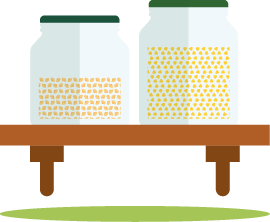
Corn, also known as maize, is one of the world’s leading cereal grains along with rice and wheat. Popcorn, a special kind of flint maize, is also considered a whole grain.
Corn is used for the production of flour (coarse cornmeal, fine cornflour), bread (tortillas, arepa), snacks, porridge, gruel, steamed products, alcoholic (beer) and non-alcoholic beverages, and breakfast cereals (corn flakes).
Corn pairs well with chiles, berries, stone fruit, aromatic spices, tomatoes, cumin, peppers, and beans.

Cornmeal is a source of fibre and vitamin B6.
Popcorn (plain, popped without oil) is high in phosphorus, copper, and thiamine (vitamin B1). It’s also a source of fibre and magnesium.
Corn flakes are a source of fibre and vitamin B6.
Corn is gluten-free.

Toggle with the tables below to compare their nutritional content per 100 g (both cooked and uncooked) and per average portion size. You might be surprised by the differences!
| Grains | Kcal | Protein | Fat | Saturated fat | Carbohydrates | Fibre |
|---|---|---|---|---|---|---|
| Corn flakes, Per 100 g, cooked | 378.00 | 7 | 0 | 0 | 84 | 3 |
| Cornmeal, Per 100 g, uncooked | 361.00 | 6 | 2 | 0 | 75 | 3 |
| Popcorn, Per 100 g, cooked | 386.00 | 13 | 4 | 0 | 72 | 5 |
Whole grains are all packed with carbohydrates and dietary fibre (which is a type of carbohydrate) and are naturally low in (saturated) fat. Fibre is important for our health and the prevention of many chronic diseases. That’s why the European Food Safety Authority (EFSA) recommends we eat at least 25 g of fibre per day. Sometimes, you might see whole grains labelled as ‘high in fibre’ or ‘source of fibre’ – but what does that really mean?
| Grains (% of DRV) | Calcium | Magnesium | Phosphorus | Potassium | Iron | Zinc | Copper | Vit. B1 | Vit. B2 | Vit. B3 | Vit. B6 | Folate |
|---|---|---|---|---|---|---|---|---|---|---|---|---|
| Corn flakes, per 100 g, cooked | 0.63 | 2.67 | 7.14 | 5.00 | 0.71 | 2.00 | 3.00 | 14.55 | 5.71 | 6.88 | 15.71 | 4.55 |
| Corn flakes, per portion, cooked | 0.19 | 0.80 | 2.14 | 1.50 | 0.21 | 0.60 | 0.90 | 4.36 | 1.71 | 2.06 | 4.71 | 1.36 |
| Cornmeal, per 100 g, uncooked | 0.75 | 12.53 | 14.14 | 6.00 | 0.71 | 3.00 | 15.00 | 30.00 | 7.86 | 0.63 | 23.57 | 6.06 |
| Cornmeal, per portion, uncooked | 0.60 | 10.03 | 11.31 | 4.80 | 0.57 | 2.40 | 12.00 | 24.00 | 6.29 | 0.50 | 18.86 | 4.85 |
| Popcorn, per 100 g, cooked | 1.38 | 22.93 | 40.14 | 12.00 | 7.86 | 1.00 | 42.00 | 35.45 | 8.57 | 13.75 | 0.00 | 0.00 |
| Popcorn, per portion, cooked | 0.55 | 9.17 | 16.06 | 4.80 | 3.14 | 0.40 | 16.80 | 14.18 | 3.43 | 5.50 | 0.00 | 0.00 |
% of DRV stands for dietary reference value. DRV stands for dietary reference value. These values estimate how much of a nutrient most healthy people in Europe need each day. Ideally, we should aim to reach 100% of these values daily. Each vitamin and mineral has their own DRV, as set by EFSA.
You might have heard that whole grains are ‘high in,’ ‘rich in,’ or ‘source of’ a certain vitamin or mineral. These term are regulated by EFSA and products must meet specific rules to be considered as such. Here’s how to interpret these contributions:

Store in an airtight container in a cool, dry place. Follow the instructions on the packaging to keep the food good for as long as possible.
Corn products have a best-before date, meaning that it can often be eaten after that date has passed. If it looks, smell and tastes good, and the packaging is also intact, it will most likely be safe.

Follow the instructions on the packaging to cook cornmeal.
As a general rule of thumb, use a ratio of 1 part of cornmeal to 4 parts of water. Bring to boil, then simmer 25-35 minutes until tender.
Cornmeal is best suited for porridge or polenta style recipes or to thicken stews.

Degerminated corn and fresh corn, corn on the cob, sweetcorn are not considered a whole grain.
Learn to identify whole grain products, cook delicious meals, find practical tips for a smooth, gradual switch, and much more!